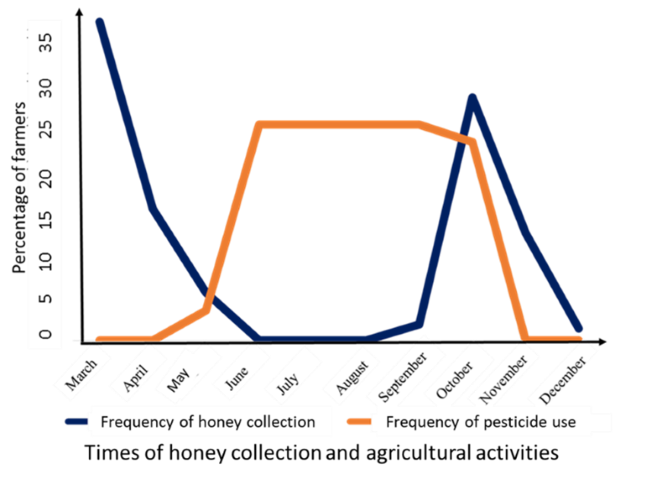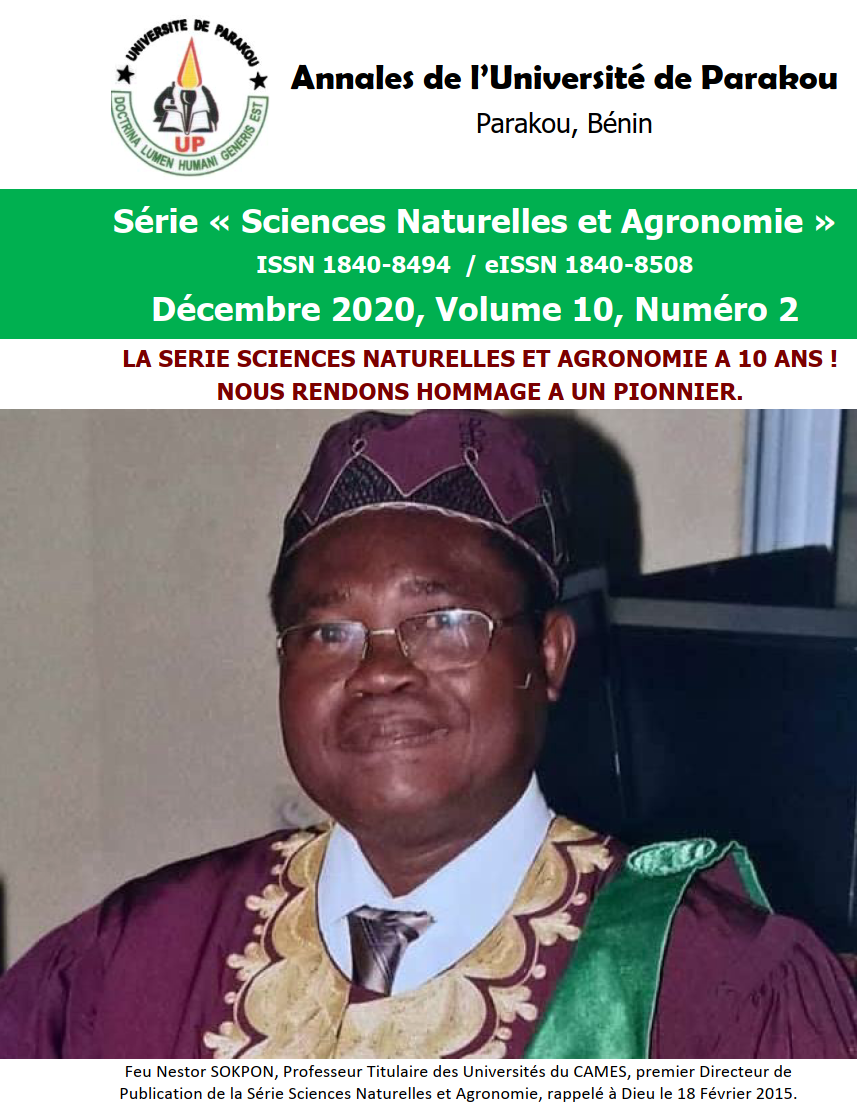Farmer’s perception of agrochemical use on honeybees and honey production in Benin: Implication for organic honey production
DOI :
https://doi.org/10.56109/aup-sna.v12i2.25Mots-clés :
Apiculture, produits chimiques, abeilles, production du miel, BéninRésumé
Beekeeping faces numerous challenges, including the use of agrochemicals. Honeybee colonies are lost because of chemical pesticides use in agriculture to control pests and diseases, which affects detoxifying mechanisms and immune responses, making them more vulnerable to parasites. The purpose of this study was to investigate people’s perception of the impact of agricultural pesticide use on the honeybee community and honey production in northern Benin. A survey was conducted using a questionnaire among 100 beekeepers. Individual interviews were used to gather information on treated crops, the distance between beehives and these cultivated fields, the effect of pesticides and herbicides, alternative methods to pesticide use and honey production. Chemical pesticides such as Callifor G, Kalach, Atrazila 80 WP, Herbextra, Atraforce, Adwumawura (480 SL), Cottonex, Thalis, Cotonix and Cypercal P 330 EC were used in agricultural fields, and beehives were typically found near treated fields. The majority of beekeepers (79%) are aware of the risks associated with pesticides and employ non-pesticide alternatives such as biopesticides to minimize them. In general, beekeepers reported a reduction in the big breed of bees and a 40% decrease in the little breed. When the beehives were placed far away from the treated areas, the honey yield was higher. Alternative pest management strategies to farmers' pesticide use would result in long-term increases in honey production and would constitute the main step of the conversion to organic apiculture in northern Benin.
Téléchargements
Références
Abdu-Allah, G. A., Pittendrigh, B. R. 2018. Lethal and sub-lethal effects of select macrocyclic lactones insecticides on forager worker honey bees under laboratory experimental conditions. Ecotoxicology 1:81-88. DOI: https://doi.org/10.1007/s10646-017-1872-6
Adomou, A. C., Agban, O. P., Sinsin, B. 2011. Plantes. Protection de la nature en Afrique de l’Ouest: Une liste rouge pour le Bénin. Nature Conservation in West Africa: Red List for Benin, 21-46.
Aktar, W., Sengupta, D., Chowdhury, A. 2009. Impact of pesticides use in agriculture: their benefits and hazards. International journal of Toxicology 1:1-12. DOI: https://doi.org/10.2478/v10102-009-0001-7
Amulen, D. R., Spanoghe, P., Houbraken, M., Tamale, A., de Graaf, D. C., Cross, P., Smagghe, G. 2017. Environmental contaminants of honeybee products in Uganda detected using LC-MS/MS and GC-ECD. PloSone 12(6), e0178546. DOI: https://doi.org/10.1371/journal.pone.0178546
Bakker, L., van der Werf, W., & Bianchi, F. J. 2022. Sweep netting samples, but not sticky trap samples, indicate beneficial arthropod abundance is negatively associated with landscape wide insecticide use. Journal of Applied Ecology, 59(4), 942-952. DOI: https://doi.org/10.1111/1365-2664.14106
Berenbaum, M. R., & Johnson, R. M. 2015. Xenobiotic detoxification pathways in honey bees. Current Opinion in Insect Science 10: 51-58. DOI: https://doi.org/10.1016/j.cois.2015.03.005
Bogdanov, S. 2006. Contaminants of bee products. Apidologie 37(1): 1-18. DOI: https://doi.org/10.1051/apido:2005043
Breeze, T. D., Bailey, A. P., Balcombe, K. G., & Potts, S. G. 2011. Pollination services in the UK: How important are honeybees? Agriculture, Ecosystems & Environment, 142(3-4), 137-143. DOI: https://doi.org/10.1016/j.agee.2011.03.020
Brettell, L. E, & Martin, S. J. 2017. Oldest Varroa tolerant honey bee population provides insight into the origins of the global decline of honey bees. Scientific Reports 7: 45-53. DOI: https://doi.org/10.1038/srep45953
Claudianos, C., Ranson, H., Johnson, R. M., Biswas, S., Schuler, M. A., Berenbaum, M. R., Oakeshott, J. G. 2006. A deficit of detoxification enzymes: pesticide sensitivity and environmental response in the honeybee. Insect Molecular Biology 15(5): 615-636. DOI: https://doi.org/10.1111/j.1365-2583.2006.00672.x
Colborn, T., Vom Saal, F. S., Soto, A. M. 1993. Developmental effects of endocrine-disrupting chemicals in wildlife and humans. Environmental Health Perspectives 5: 378-384. DOI: https://doi.org/10.1289/ehp.93101378
Cresswell, J. E. 2011. A meta-analysis of experiments testing the effects of a neonicotinoid insecticide (Imidacloprid) on honey bees. Ecotoxicology 1: 149-157. DOI: https://doi.org/10.1007/s10646-010-0566-0
Cresswell, J. E. 2016. The impacts of agrochemical pesticides on bees in intensively cultivated farmland. In Pollination Services to Agriculture: Sustaining and Enhancing a Key Ecosystem Service. Routledge. pp. 173-197.
Darko, G., Addai Tabi, J., Adjaloo, M. K., Borquaye, L. S. 2017. Pesticide residues in honey from the major honey producing forest belts in Ghana. Journal of Environmental and Public Health 1-6. DOI: https://doi.org/10.1155/2017/7957431
Dassou, A. G., Ogouchoro, D., Vodouhe, F. G., Dassou, H. G., Dansi, A., Tixier, P. 2019. Ethnoapicultural investigation to improve conservation status of threatened melliferous agroforestry species with high medicinal and food values in Benin. Agroforestry Systems 1-15. DOI: https://doi.org/10.1007/s10457-019-00423-2
David, A., Botías, C., Abdul-Sada, A., Nicholls, E., Rotheray, E. L., Hill, E. M., Goulson, D. 2016. Widespread contamination of wildflower and bee-collected pollen with complex mixtures of neonicotinoids and fungicides commonly applied to crops. Environmental International 88: 169-178. DOI: https://doi.org/10.1016/j.envint.2015.12.011
Doublet, V., Labarussias, M., de Miranda, J. R., Moritz, R. F., Paxton, R. J. 2015. Bees under stress: sublethal doses of a neonicotinoid pesticide and pathogens interact to elevate honey bee mortality across the life cycle. Environmental Microbiology 4: 969-983. DOI: https://doi.org/10.1111/1462-2920.12426
Fairbrother A., Purdy, J., Anderson, T., Fell, R. 2014. Risks of neonicotinoid insecticides to honeybees. Environmental Toxicology and Chemistry 33(4): 719-731. DOI: https://doi.org/10.1002/etc.2527
Fikadu, Z. 2019. The contribution of managed honey bees to crop pollination, food security, and economic stability: Case of Ethiopia. The Open Agriculture Journal, 13(1): 175-181. DOI: https://doi.org/10.2174/1874331501913010175
Genersch, E., Von Der Ohe, W., Kaatz, H., Schroeder, A., Otten, C., Büchler, R., Meixner, M. 2010. The German bee monitoring project: a long term study to understand periodically high winter losses of honey bee colonies. Apidologie 41(3): 332-352. DOI: https://doi.org/10.1051/apido/2010014
Genersch, E. 2010. Honey bee pathology: current threats to honey bees and beekeeping. Applied Microbiology and Biotechnology 1: 87-97. DOI: https://doi.org/10.1007/s00253-010-2573-8
Gentilcore, R. L. 1960. Ontario, California and the Agricultural Boom of the 1880s. Agricultural History 34(2): 77-87.
Girard, C., Picard-Nizou, A. L., Grallien, E., Zaccomer, B., Jouanin, L., Pham-Delegue, M. H. 1998. Effects of proteinase inhibitor ingestion on survival, learning abilities and digestive proteinases of the honeybee. Transgenic Research 4: 239-246. DOI: https://doi.org/10.1023/A:1008813910751
Gomes, T., Feás, X., Iglesias, A., Estevinho, L. M. 2011. Study of organic honey from the northeast of Portugal. Molecules 7: 5374-5386. DOI: https://doi.org/10.3390/molecules16075374
Hacura, A., Jadamus-Hacura, M., Kocot, A. 2001. Risk analysis in investment appraisal based on the Monte Carlo simulation technique. The European Physical Journal B-Condensed Matter and Complex Systems, 20: 551-553 DOI: https://doi.org/10.1007/s100510170238
Hapke, S. D. 2008. Integrated Management of Varroa Destructor Anderson & Trueman (Acari: Varroidae) in Honey Bees, Apis Mellifera L. (Hymenoptera: Apidae), in Western Washington State, USA (Doctoral dissertation, Washington State University).
Hounkpe, N., Mensah, G. A., Koutinhouin, B., Pomalegni, S., Goergen, G. 2007. Typisation des abeilles melliferes dans le Nord Benin. Bulletin de la Recherche Agronomique du Bénin 58: 56-59.
Iloba, B. N., Ekrakene, T. 2008. Soil micro arthropods recovery rates from 0–5 cm depth within 5 months period following endosulfan (organochlorine pesticide) treatment in designated plots in Benin City, Nigeria. Academy Journal of Entomology 1:36-44.
Isenring, R. 2010. Pesticides and the loss of biodiversity. Pesticide Action Network Europe, London, 26.
James, R. R., & Xu, J. 2012. Mechanisms by which pesticides affect insect immunity. Journal of invertebrate pathology 109(2): 175-182. DOI: https://doi.org/10.1016/j.jip.2011.12.005
Johansen, C. A., Mayer, D. F., Eves, J. D., Kious, C. W. 1983. Pesticides and bees. Environmental Entomology 5: 1513-1518. DOI: https://doi.org/10.1093/ee/12.5.1513
Lee-Mäder, E., Vaughan, M., & Goldenetz-Dollar, J. 2020. Agroforestry and cover cropping for pollinators. In Gemmill-Herren, B., Azzu, N., Bicksler, A., and A. Guidotti (eds.). Towards Sustainable Crop Pollination Services: Measures at Field, Farm and Landscape Scales (pp. 105-126). Food and Agriculture Organization of the United Nations.
Lernoud, J., Willer, H., & Schlatter, B. 2019. Africa: current statistics. The World of organic agriculture, 179.
Maderson, S. 2023. Co-producing agricultural policy with beekeepers: Obstacles and opportunities. Land Use Policy, 128: 106603. DOI: https://doi.org/10.1016/j.landusepol.2023.106603
Mullin, C. A., Frazier, M., Frazier, J. L., Ashcraft, S., Simonds, R., Pettis, J. S. 2010. High levels of miticides and agrochemicals in North American apiaries: implications for honey bee health. PloSone 3: e9754. DOI: https://doi.org/10.1371/journal.pone.0009754
Osborne, J. L., Williams, I. H., Corbet, S. A. 1991. Bees, pollination and habitat change in the European community. Bee World 3: 99-116. DOI: https://doi.org/10.1080/0005772X.1991.11099088
Panseri, S., Catalano, A., Giorgi, A., Arioli, F., Procopio, A., Britti, D., Chiesa, L. M. 2014. Occurrence of pesticide residues in Italian honey from different areas in relation to its potential contamination sources. Food Control 38: 150-156. DOI: https://doi.org/10.1016/j.foodcont.2013.10.024
Paraiso, A., Olodo, G. P., Tokoudagba, S., Auteu, R., Yegbemey, R. N., Sanni, A. 2012. Déterminants et contraintes de la production du miel dans le Nord-Ouest du Bénin: Cas des communes de Natitingou et de Tanguiéta. Journal de la Recherche Scientifique de l’Université de Lomé 1: 69-82.
Pazou, E. Y. A., Boko, M., Van Gestel, C. A., Ahissou, H., Lalèyè, P., Akpona, S., van Straalen, N. M. 2006. Organochlorine and organophosphorous pesticide residues in the Ouémé River catchment in the Republic of Bénin. Environmental International 5: 616-623. DOI: https://doi.org/10.1016/j.envint.2006.01.007
Platon, V., Constantinescu, A. 2014. Monte Carlo Method in risk analysis for investment projects. Procedia Economics and Finance 15: 393–400. DOI: https://doi.org/10.1016/S2212-5671(14)00463-8
Resende, G. C., Alvarenga, E. S., de Araújo, T. A., Campos, J. N., Pincanço, M. C. 2016. Toxicity to Diaphania hyalinata, selectivity to non‐target species and phytotoxicity of furanones and phthalide analogues. Pest Management Science 72(9): 1772-1777. DOI: https://doi.org/10.1002/ps.4210
Robbins, P., Sharp, J. 2003. The lawn‐chemical economy and its discontents. Antipode 5: 955-979. DOI: https://doi.org/10.1111/j.1467-8330.2003.00366.x
Sutherland, W. J., Butchart, S. H., Connor, B., Culshaw, C., Dicks, L. V., Dinsdale, J., Jiang, Z. 2018. A 2018 horizon scan of emerging issues for global conservation and biological diversity. Trends in Ecology & Evolution 33(1): 47-58. DOI: https://doi.org/10.1016/j.tree.2017.11.006
Thompson, H. M. 2003. Behavioural effects of pesticides in bees–their potential for use in risk assessment. Ecotoxicology 1-4: 317-330. DOI: https://doi.org/10.1023/A:1022575315413
Togbé, C. E., Haagsma, R., Aoudji, A. K., Vodouhê, S. D. 2015. Effect of participatory research on farmers’ knowledge and practice of IPM: the case of cotton in Benin. The Journal of Agricultural Education and Extension 21(5): 421-440. DOI: https://doi.org/10.1080/1389224X.2014.971829
Tubbs, C. W., & McDonough, C. E. 2018. Reproductive impacts of endocrine-disrupting chemicals on wildlife species: implications for conservation of endangered species. Annual Review of Animal Biosciences 6: 287-304. DOI: https://doi.org/10.1146/annurev-animal-030117-014547
Tucak, Z., Periškić, M., Bešlo, D., Tucak, I. 2004. Influence of the beehive type on the quality of honey. Collegium Antropologicum 28(1): 463-467.
Vanhove, W., Yao, R. K., N’Zi, J. C., Toussaint, L. A. N. G., Kaminski, A., Smagghe, G., Van Damme, P. 2020. Impact of insecticide and pollinator-enhancing substrate applications on cocoa (Theobroma cacao) cherelle and pod production in Côte d’Ivoire. Agriculture, Ecosystems & Environment 293: 106855. DOI: https://doi.org/10.1016/j.agee.2020.106855
Wilfert, L., Long, G., Leggett, H. C., Schmid-Hempel, P., Butlin, R., Martin, S. J. M., Boots, M. 2016. Deformed wing virus is a recent global epidemic in honeybees driven by Varroa mites. Sciences 6273: 594-597. DOI: https://doi.org/10.1126/science.aac9976
Zoclanclounon, D. G., Paraïso, G., Paraïso, A., Akogbeto, F., Quenum, G. 2017. Sensitivity of Bee Apis mellifera adansonii to a Fungicide Commonly Used in Benin. International Journal of Environmental Science and Technology 3: 1-9.

Téléchargements
Publiée
Comment citer
Numéro
Rubrique
Catégories
Licence
(c) Tous droits réservés Anicet DASSOU, Corinne ANAGONOU, Sènan VODOUHE, Aristide ADJAI-EDIKOU, Silvère TOVIGNAN, Barrès DASSOU, Delphine BODJRENOU, Valentin KINDOMIHOU, Léonard AFOUDA, Simplice VODOUHE 2023

Ce travail est disponible sous la licence Creative Commons Attribution 4.0 International .












